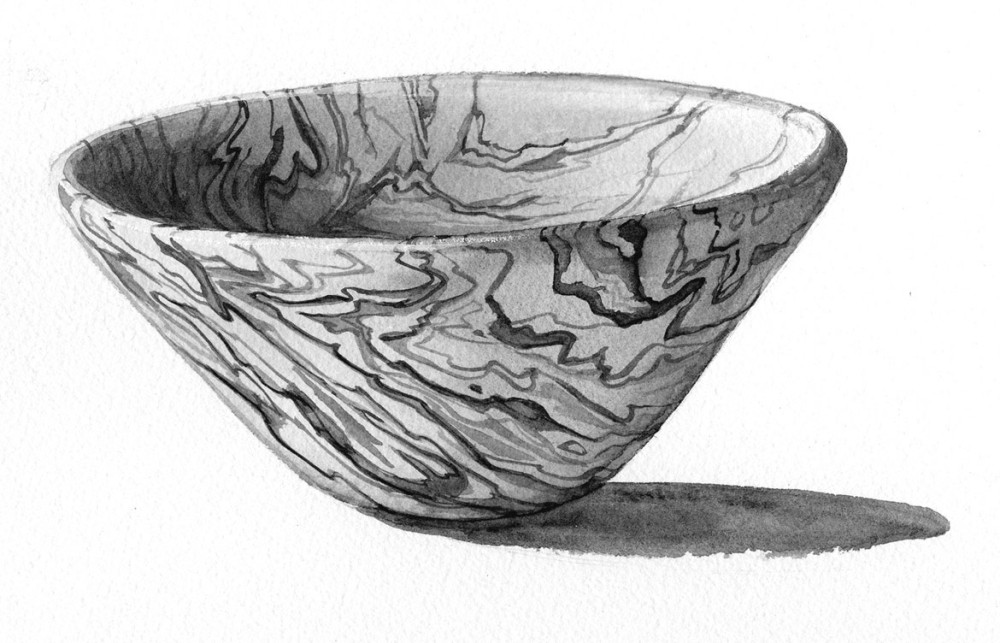
Anyone who has ever mismanaged a pile of firewood has probably seen spalted wood: wood in a relatively early stage of decomposition that is irregularly bleached and vividly marked with thin, dark lines. They are called zone lines, but they are not really lines at all. Each of the decorative “lines” in a piece of firewood that has been out in the weather a bit too long is the edge of a sheet.
And anyone who has kicked a hardwood stump in the final stage of decomposition is likely to have puzzled over these same weird, rubbery sheets, because they remain relatively intact when the wood in a stump is so thoroughly decayed that your boot can sweep right through it. Zone lines surround the territory claimed by a particular fungus, and, like a fence, they keep the fungal neighbor on the other side from encroaching.
Fungal spores are produced by the millions, and it doesn’t take long for a stump or hunk of firewood or any other piece of moist dead wood to be invaded by a number of different species of fungus, all competing for the same resources.
Zone lines are constructed by genetically different individuals wherever they meet and are very effective at separating the competitors, leaving each one free to consume the wood on only its side of the fence. Sometimes the fungus across the fence is closely related, and other times it might be a distant cousin. Both of the competing fungi contribute to building the zone line, which is made up of dead fungal hyphae along with high concentrations of the gums, resins, and phenolics that are found in wood.
The disassembly and consumption of a piece of wood is a complicated process. The fungi that were happily living in a chunk of firewood at the spalted stage may not have been the first decomposing species to occupy that territory and probably will not be the last. It normally takes a succession of specialists to turn a solid piece of lignin and cellulose into mush.
Most of the fungi implicated in spalting are in the group called white rotters. Common in hardwoods, these species break down more lignin than cellulose, ultimately leaving wood soft, stringy, and white. Brown rotters, on the other hand, are more often associated with conifers, and they consume more of the cellulose. This turns wood into brown cubes composed mostly of lignin.
The white rotter Armillaria, or shoestring root rot, makes good zone lines, and so does Ganoderma applanatum, commonly called artist’s conk because of the impressionable white underside of its fruiting body. But these members of the group called basidiomycetes, known for their large, spore-producing mushrooms and conks, are not the only creators of zone lines. Ascomycetes, another large but less-well-known family of fungi, are even more often associated with spalting. Perhaps, without realizing it, you have seen the fruiting bodies of ascomycetes. About when the bark sloughs off, the surface of a piece of wood may have a crumbly, dark crust on it, a crust that is made up of the very tiny, spore-bearing cups that are typical of many ascomycetes.
In the spalted stage, wood still has structural integrity. BTUs have been lost, fungal hyphae have invaded, and, if it’s kept warm and wet, disintegration is just around the corner. But woodworkers, especially woodturners, get very excited by wood like this: wood that is on the edge, that is dramatic and fascinating, but hasn’t yet become unusable. Because they indicate the presence of decay, zone lines might sound like nothing but trouble, yet the dramatic effect of wandering black lines can add enormously to the character of a wooden bowl or the panels in a cabinet. Zone lines are especially dramatic in light-colored wood, such as maple.
Some woodworkers bury perfectly sound pieces of wood in the ground or put them in plastic bags with such inducements as beer and fertilizer to get that spalted look. Warm, moist conditions will cause spalting in a number of species, but there are so many variables – species, temperature, moisture content, the kinds of fungi at work – that knowing when wood is at its spalted best is very tricky. If the spalting process is stopped by drying the wood out too soon, it’s just not all that interesting. If left too long, the wood may look terrific, but it will be so punky that it’s unworkable and is a sanding and finishing nightmare.
People go to great lengths to slow the inevitable consumption of wood by fungi. Could the chemical constituents of zone lines be useful in formulating a less-toxic wood preservative? Maybe the idea is as unworkable as late-stage spalted wood. But wouldn’t it be nice if fungi themselves could be helpful in the battle against wood decay?

